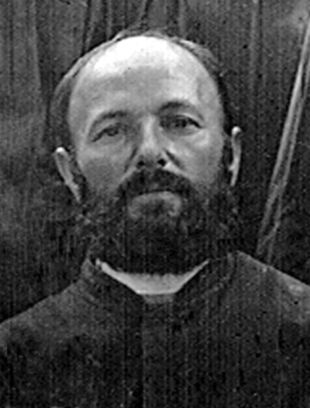View entry
Name: DILLENSEGER, Alois 'Brother Blanchard' (Brother)

Birth Date: 23.10.1858 Breitenbach, Alsace
Death Date: 3.8.1904 Bagamoyo
First Date: 1888
Last Date: 1904
Profession: Missionary
Area: Mombasa, Nairobi, Zanzibar, Pemba
Book Reference: North, Josephine O'Hare, Baur
General Information:
North - Holy Ghost Fathers - 'Br. Blanchard'; arr. Bagamoyo from France 1888; specialised in vegetable gardens and coffee plantation; Kilema 1891; visiting Taveta June/July 1895; Mombasa nursing plague victims 1896; dep. Mombasa with party to open St. Austin's Mission near Nairobi 11/8/1899; transferred to Pemba 1902; Zanzibar 1904
Holy Ghost Fathers; Kilema Mission; Visiting Taveta June/July 1895; left Mombasa
with party to open mission at Nairobi 11-8-1899
Josephine O'Hare - Coffee and the Holy Ghost Fathers - Fr. Blanchard of St. Austin's was a very industrious farmer and had been able to send to Mr Whitehouse, Chief Engineer of the Railway, a gift of fresh vegetables from the mission's gardens a couple of months after his arrival with Mgr. Allgeyer [1899].
Henry J. Koren, Spiritan East African Memorial, 1994: After serving in the German army, he worked some time in a college at Dijon, France, until in 1885 he could enter the Congregation at Chevilly. He made his vows there on September 8, 1887 and then served for one year at the orphanage of St. Joseph du Lac. ln 1888 his wish to serve in Africa was granted and he could go to Bagamoyo. As he was a farmer by trade, he was an obvious choice for being placed in charge of its famous plantations, while also supervising and teaching the boys of the orphanage cum trade school of the mission. His expertise earned him great praise of the German Govemor General of German East Africa, Von Scheele, who happened to be his former army commander.
ln 1891 he went to the new mission of Kilema, where he laid out fruit and vegetable gardens as well as a coffee plantation. ln 1896 he did the same at Mhonda. Never a man to rest, when he was supposed to enjoy a brief vacation in Zanzibar, he helped in the construction of its new cathedral, then went off to Mombasa to nurse victims of a smallpox epidemic. Next, we find him at the new mission of St. Austin in what is now Nairobi, laying out gardens and a coffee plantation. As in Tanganyika, these plantations became a great boon to the economy of Kenya; the entire coffee industry of that country is derived from the work of this man.Even today it still accounts for more than 25% of its total exports. In 1902 he was transferred to Pemba, then a new mission, where everything had to be built up from scratch. Of course, he laid out plantations here. Two years later we find him in Zanzibar, where he looked after the fruit and vegetable gardens and occupied himself also with the care of the lepers for whom no separate facilities, staffed by nurses, had yet been built. He did not hesitate to sleep with them in the miserable huts that were their abode. He caught pneumonia there and some lung disease for which there was no cure. But he declined being returned to Europe and preferred to die in his beloved Africa. Transported to Bagamoyo he died there soon after. He was one of those splendid Brothers who rendered the greatest services to the Congregation's mission and the people in East Africa, while being at the same time holy religious men of boundless charity and love for all human beings they came into contact with.
ln 1891 he went to the new mission of Kilema, where he laid out fruit and vegetable gardens as well as a coffee plantation. ln 1896 he did the same at Mhonda. Never a man to rest, when he was supposed to enjoy a brief vacation in Zanzibar, he helped in the construction of its new cathedral, then went off to Mombasa to nurse victims of a smallpox epidemic. Next, we find him at the new mission of St. Austin in what is now Nairobi, laying out gardens and a coffee plantation. As in Tanganyika, these plantations became a great boon to the economy of Kenya; the entire coffee industry of that country is derived from the work of this man.Even today it still accounts for more than 25% of its total exports. In 1902 he was transferred to Pemba, then a new mission, where everything had to be built up from scratch. Of course, he laid out plantations here. Two years later we find him in Zanzibar, where he looked after the fruit and vegetable gardens and occupied himself also with the care of the lepers for whom no separate facilities, staffed by nurses, had yet been built. He did not hesitate to sleep with them in the miserable huts that were their abode. He caught pneumonia there and some lung disease for which there was no cure. But he declined being returned to Europe and preferred to die in his beloved Africa. Transported to Bagamoyo he died there soon after. He was one of those splendid Brothers who rendered the greatest services to the Congregation's mission and the people in East Africa, while being at the same time holy religious men of boundless charity and love for all human beings they came into contact with.
